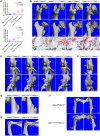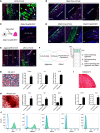NFAT restricts osteochondroma formation from entheseal progenitors
- PMID: 27158674
- PMCID: PMC4855520
- DOI: 10.1172/jci.insight.86254
NFAT restricts osteochondroma formation from entheseal progenitors
Abstract
Osteochondromas are common benign osteocartilaginous tumors in children and adolescents characterized by cartilage-capped bony projections on the surface of bones. These tumors often cause pain, deformity, fracture, and musculoskeletal dysfunction, and they occasionally undergo malignant transformation. The pathogenesis of osteochondromas remains poorly understood. Here, we demonstrate that nuclear factor of activated T cells c1 and c2 (NFATc1 and NFATc2) suppress osteochondromagenesis through individual and combinatorial mechanisms. In mice, conditional deletion of NFATc1 in mesenchymal limb progenitors, Scleraxis-expressing (Scx-expressing) tendoligamentous cells, or postnatally in Aggrecan-expressing cells resulted in osteochondroma formation at entheses, the insertion sites of ligaments and tendons onto bone. Combinatorial deletion of NFATc1 and NFATc2 gave rise to larger and more numerous osteochondromas in inverse proportion to gene dosage. A population of entheseal NFATc1- and Aggrecan-expressing cells was identified as the osteochondroma precursor, previously believed to be growth plate derived or perichondrium derived. Mechanistically, we show that NFATc1 restricts the proliferation and chondrogenesis of osteochondroma precursors. In contrast, NFATc2 preferentially inhibits chondrocyte hypertrophy and osteogenesis. Together, our findings identify and characterize a mechanism of osteochondroma formation and suggest that regulating NFAT activity is a new therapeutic approach for skeletal diseases characterized by defective or exaggerated osteochondral growth.
Figures








References
-
- Huegel J, Enomoto-Iwamoto M, Sgariglia F, Koyama E, Pacifici M. Heparanase stimulates chondrogenesis and is up-regulated in human ectopic cartilage: a mechanism possibly involved in hereditary multiple exostoses. Am J Pathol. 2015;185(6):1676–1685. doi: 10.1016/j.ajpath.2015.02.014. - DOI - PMC - PubMed
-
- Khurana J, Abdul-Karim F, Bovee JVMG. Osteochondroma. In: Fletcher CDM, Bridge JA, Hogendoorn PCW, Mertens F, eds. WHO Classification of Tumours of Soft Tissue and Bone. 4th ed. Lyon, France: International Agency for Research on Cancer; 2013:234–236.
-
- Kitsoulis P, et al. Osteochondromas: review of the clinical, radiological and pathological features. In Vivo. 2008;22(5):633–646. - PubMed
Grants and funding
LinkOut - more resources
Full Text Sources
Other Literature Sources
Molecular Biology Databases
Research Materials
Miscellaneous

